
The true finches are small to medium-sized passerine birds in the family Fringillidae. Finches generally have stout conical bills adapted for eating seeds and nuts and often have colourful plumage. They occupy a great range of habitats where they are usually resident and do not migrate. They have a worldwide native distribution except for Australia and the polar regions. The family Fringillidae contains more than two hundred species divided into fifty genera. It includes the canaries, siskins, redpolls, serins, grosbeaks and euphonias, as well as the morphologically divergent Hawaiian honeycreepers.
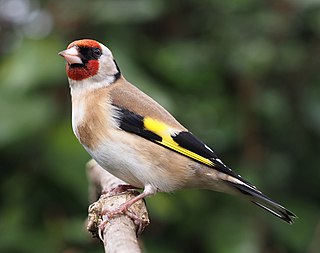
The European goldfinch or simply the goldfinch is a small passerine bird in the finch family that is native to Europe, North Africa and western and central Asia. It has been introduced to other areas, including Australia, New Zealand and Uruguay.

The genus Carduelis is a group of birds in the finch family Fringillidae.
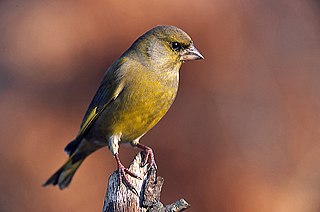
The European greenfinch or simply the greenfinch is a small passerine bird in the finch family Fringillidae.
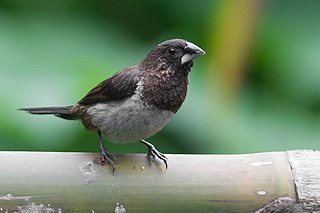
The white-rumped munia or white-rumped mannikin, sometimes called striated finch in aviculture, is a small passerine bird from the family of waxbill "finches" (Estrildidae). These are not close relatives of the true finches (Fringillidae) or true sparrows (Passeridae).

The red-cheeked cordon-bleu or red-cheeked cordonbleu is a small passerine bird in the family Estrildidae. This estrildid finch is a resident breeding bird in drier regions of tropical Sub-Saharan Africa. Red-cheeked cordon-bleu has an estimated global extent of occurrence of 7,700,000 km2.

The white-winged snowfinch, or snowfinch, is a small passerine bird. Despite its name, it is a sparrow rather than a true finch.

The Cape longclaw or orange-throated longclaw is a passerine bird in the family Motacillidae, which comprises the longclaws, pipits and wagtails. It occurs in Southern Africa in Zimbabwe and southern and eastern South Africa. This species is found in coastal and mountain grassland, often near water.

Pyrrhula is a small genus of passerine birds, commonly called bullfinches, belonging to the finch family (Fringillidae). The genus has a Palearctic distribution; almost all species occur in Asia, with two species exclusively in the Himalayas and one species, P. pyrrhula, also occurring in Europe. The Azores bullfinch is a critically endangered species, occurring only in the east of the island of São Miguel in the Azores archipelago.

The British finches are made up of several species of finch which were formerly very popular as cage birds in Great Britain. They are not currently commonplace, but are still kept by a few dedicated fanciers.

The yellow bishop, also known as Cape bishop, Cape widow or yellow-rumped widow, is a resident breeding bird species in Angola, Botswana, Burundi, Cameroon, Congo, Equatorial Guinea, Eswatini, Ethiopia, Kenya, Lesotho, Malawi, Mozambique, Nigeria, Rwanda, South Africa, South Sudan, Tanzania, Uganda, Zambia and Zimbabwe.

The yellow canary is a small passerine bird in the true finch family. It is a resident breeder in much of the western and central regions of southern Africa and has been introduced to Ascension and St Helena islands.

The brimstone canary or bully canary is a small passerine bird in the finch family. It is a resident breeder in central and southern Africa.
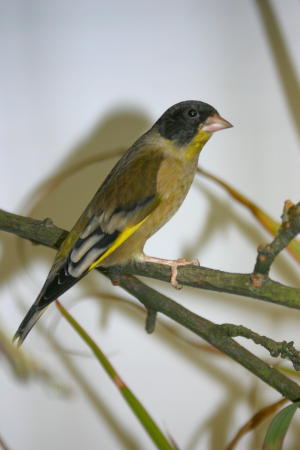
The black-headed greenfinch is a small passerine bird in the family Fringillidae. It is found in the Chinese province of Yunnan, northern Laos, eastern Myanmar and adjacent areas of Vietnam, Thailand and Northeast India. Its natural habitats are subtropical or tropical dry forest and subtropical or tropical dry shrubland.
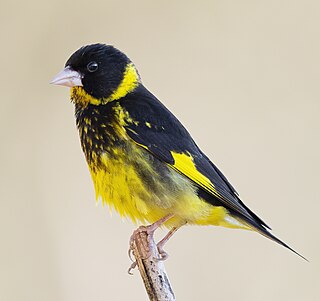
The Vietnamese greenfinch is a small passerine bird in the family Fringillidae. It is found only in Đà Lạt Plateau of southern Vietnam. Its natural habitat is open montane pine forest and scrubland. It is threatened by habitat loss.
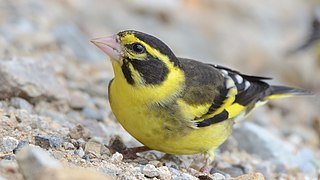
The yellow-breasted greenfinch is a small passerine bird in the family Fringillidae that is native to the northern regions of the Indian subcontinent.

The purple-throated euphonia is a songbird species in the family Fringillidae. It was formerly placed in the Thraupidae.

The greenfinches are small passerine birds in the genus Chloris in the subfamily Carduelinae within the Fringillidae. The species have a Eurasian distribution except for the European greenfinch, which also occurs in North Africa.

The slender-billed greenfinch("Carduelis" aurelioi) is an extinct songbird in the finch family Fringillidae. It was endemic to the island Tenerife in the Canary Islands, and became extinct after human settlement of the islands.
The Bonin greenfinch, also known as the Ogasawara greenfinch, is a small passerine bird in the finch family Fringillidae that is endemic to the Ogasawara Islands of Japan, where it is found on the Bonin Islands and Volcano Islands. It was formerly considered a subspecies of the grey-capped greenfinch and some authorities consider it as such, but a 2020 analysis found it likely to represent a distinct species that diverged from C. sinica about 1.06 million years ago, and the International Ornithological Congress now recognizes it as such, making it the eleventh endemic species in Japan. There are fewer than 400 individuals in the population and it is considered critically endangered by the Japanese government, necessitating protection. According to the Yamashina Institute for Ornithology, as of December 2021, the Ogaswara greenfinch is Japan's most endangered bird.






















